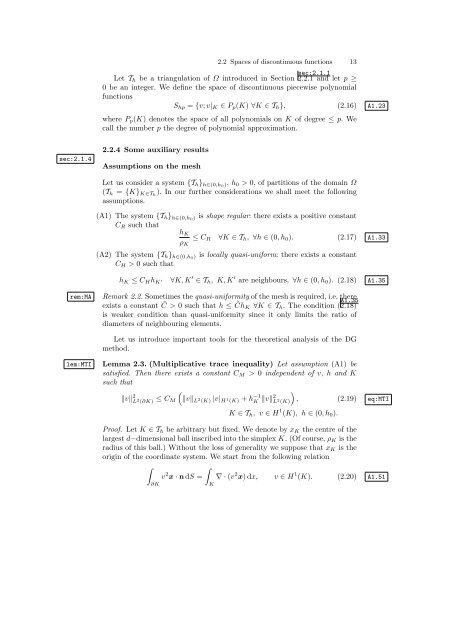2 DGM for elliptic problems
2 DGM for elliptic problems
2 DGM for elliptic problems
You also want an ePaper? Increase the reach of your titles
YUMPU automatically turns print PDFs into web optimized ePapers that Google loves.
2.2 Spaces of discontinuous functions 13<br />
Let T h be a triangulation of Ω introduced in Section sec:2.1.1 2.2.1 and let p ≥<br />
0 be an integer. We define the space of discontinuous piecewise polynomial<br />
functions<br />
S hp = {v;v| K ∈ P p (K) ∀K ∈ T h }, (2.16) A1.23<br />
where P p (K) denotes the space of all polynomials on K of degree ≤ p. We<br />
call the number p the degree of polynomial approximation.<br />
sec:2.1.4<br />
2.2.4 Some auxiliary results<br />
Assumptions on the mesh<br />
Let us consider a system {T h } h∈(0,h0), h 0 > 0, of partitions of the domain Ω<br />
(T h = {K} K∈Th ). In our further considerations we shall meet the following<br />
assumptions.<br />
(A1) The system {T h } h∈(0,h0) is shape regular: there exists a positive constant<br />
C R such that<br />
h K<br />
ρ K<br />
≤ C R ∀K ∈ T h , ∀h ∈ (0,h 0 ). (2.17) A1.33<br />
(A2) The system {T h } h∈(0,h0) is locally quasi-uni<strong>for</strong>m: there exists a constant<br />
C H > 0 such that<br />
h K ≤ C H h K ′ ∀K,K ′ ∈ T h , K,K ′ are neighbours, ∀h ∈ (0,h 0 ). (2.18) A1.35<br />
rem:MA<br />
Remark 2.2. Sometimes the quasi-uni<strong>for</strong>mity of the mesh is required, i.e. there<br />
exists a constant ˜C > 0 such that h ≤ ˜Ch K ∀K ∈ T h . The condition ( 2.18)<br />
A1.35<br />
is weaker condition than quasi-uni<strong>for</strong>mity since it only limits the ratio of<br />
diameters of neighbouring elements.<br />
Let us introduce important tools <strong>for</strong> the theoretical analysis of the DG<br />
method.<br />
lem:MTI<br />
Lemma 2.3. (Multiplicative trace inequality) Let assumption (A1) be<br />
satisfied. Then there exists a constant C M > 0 independent of v, h and K<br />
such that<br />
(<br />
)<br />
‖v‖ 2 L 2 (∂K) ≤ C M ‖v‖ L2 (K) |v| H1 (K) + h −1<br />
K ‖v‖2 L 2 (K) , (2.19) eq:MTI<br />
K ∈ T h , v ∈ H 1 (K), h ∈ (0,h 0 ).<br />
Proof. Let K ∈ T h be arbitrary but fixed. We denote by x K the centre of the<br />
largest d−dimensional ball inscribed into the simplex K. (Of course, ρ K is the<br />
radius of this ball.) Without the loss of generality we suppose that x K is the<br />
origin of the coordinate system. We start from the following relation<br />
∫<br />
∫<br />
v 2 x · ndS = ∇ · (v 2 x)dx, v ∈ H 1 (K). (2.20) A1.51<br />
∂K<br />
K
















